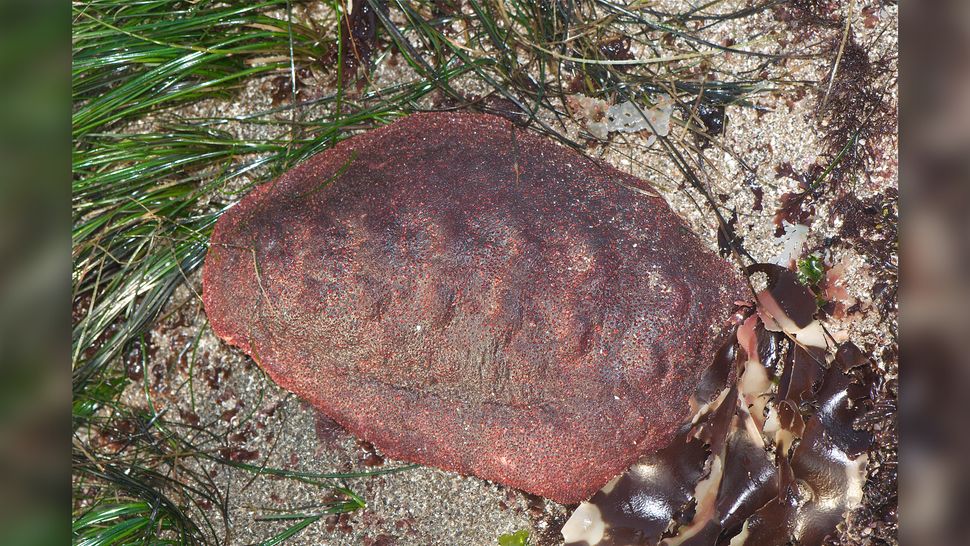Science
Related: About this forum'Wandering meatloaf' creature has teeth of iron
By Laura Geggel - Editor about 22 hours ago
Its teeth sport a rare iron mineral.

A mosaic image of the "wandering meatloaf's" whole tongue-like radula, detailing all stages of development. (Image credit: Northwestern University)
A weird mollusk, affectionately known as the "wandering meatloaf," has teeth made of a rare iron mineral, previously found only along rocky coastlines, a new study finds.
Researchers detected the rare iron mineral — called santabarbaraite — in the teeth of the rock-grazing mollusk Cryptochiton stelleri, nicknamed the "wandering meatloaf" because it looks just like one with its reddish-brown, up to 14-inch-long (36 centimeters) oval-shaped and shelled body.
The discovery sheds light on how C. stelleri can scrape food off rocks, the researchers said. "[Santabarbaraite] has high water content, which makes it strong with low density. We think this might toughen the teeth without adding a lot of weight," study senior author Derk Joester, an associate professor of materials science and engineering at Northwestern University in Illinois, said in a statement.
The wandering meatloaf, which also goes by the names giant Pacific chiton and giant gumboot chiton, is the largest known species of chiton, a marine mollusk with an ovalish, flattened body that has a shell made of overlapping plates, just like a pillbug. Chitons are known for their remarkably hard teeth, which are attached to their soft, flexible tongue-like radula. While searching for food, chitons scrape their tooth-covered radula over rocks, in order to grab algae and other food.

The "wandering meatloaf" chiton, or Cryptochiton stelleri, in the wild. (Image credit: Jerry Kirkhart)
More:
https://www.livescience.com/mollusk-has-iron-teeth.html


Blue Owl
(50,482 posts)
Sneederbunk
(14,297 posts)Dave Bowman
(1,874 posts)dweller
(23,649 posts)the zipper mouth mollusk
✌🏻
soothsayer
(38,601 posts)wendyb-NC
(3,328 posts)The diversity of living creatures is always such a wonderment to me. Thanks for sharing the article, Judi Lynn.
Judi Lynn
(160,598 posts)eppur_se_muova
(36,280 posts)If was named by Gmelin in Steller's honor, following his untimely death.
https://en.wikipedia.org/wiki/Georg_Wilhelm_Steller for a list of all the Steller's this that or others.
Judi Lynn
(160,598 posts)Javaman
(62,532 posts)
Dave Bowman
(1,874 posts)
MineralMan
(146,324 posts)on the Central California coast. From time to time, I led tide pool walks for tween kids on a rocky shoreline, there. I'd find critters to show the children, and give a little talk about them. That giant chiton was a favorite, just because it looked pretty ugly on the top side. Flipped over, there was more to see. Of course, I'd replace them exactly where I found them, as I did for all creatures I showed the children.
From my extensive time exploring the tide pools, I could find most of the most interesting things anytime I was out there. There were some wonderfully beautiful nudibranchs, like Hopkins rose, that could only be found on the underside of seaweeds, so most people never saw them. There was also a spectacular flatworm, with neon blue lines on it that always amazed the kids. I could always find those, since they lived on the underside of flat rocks in the tide pools.
There were color-changing small fish, as well. Whatever I found on those trips, I described as fully as I could, describing what they ate, why they lived in the intertidal zone, etc., along with giving their common names and Latin names as well. I even knew where to find empty shells of juvenile abalone, with their iridescent colors. Those, the kids could take with them. Otherwise, everything stayed exactly where it was found.
I had friends who were schoolteachers, and they'd gather a small group of about 6 students for those nature walks. I was the funny, joking, bearded amateur naturalist who went wading to show the kids things, without their having to walk on slippery rocks or enter the pools themselves. There were also pools with safe edges where the kids could gather around, while I used a long pointer to show them things without disturbing the critters. It was fun!